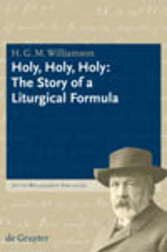Search and Find
Service
Holy, Holy, Holy: The Story of a Liturgical Formula (S. 15-16)
H. G. M. Williamson University of Oxford
In his vision recorded in Isaiah 6, the prophet reports hearing the antiphonal cry of the seraphim, usually rendered as ‘Holy, holy, holy is the Lord of hosts, the whole earth is full of his glory’ (Isa. 6:3). These familiar words have resonated long and loud through the liturgical history of both Judaism and Christianity. While the precise form of words has been varied from one setting to another (as, indeed, we shall see may have already been the case in Isaiah’s own formulation), we find that they were in continuous use from the earliest days.
According to Sweet they may have been incorporated into Jewish liturgy already in pre-Christian times, and based on 1 Clement 34:6 he suggests that they may have found their way into the Christian Eucharistic liturgy prior to their echo in Rev. 4:8, ‘Holy, holy, holy, the Lord God the Almighty, who was and is and is to come’.1 To others, however, this seems unduly optimistic. Spinks in particular, for instance, has argued that a clearer distinction should be drawn between the angelic worship as overheard by prophets and later apocalyptic mystics who were given access to the heavenly court on the one hand, and the use of the same formulae in human worship in church or syna gogue on the other.2
Spinks therefore prefers to speak only in terms of the direct attestation of the Trisagion in liturgical texts, which for the Christian Church is not earlier than the third century (in the eastern tradition). On the Jewish side, the picture is even more complicated. While there are a considerable number of closer or remote allusions to Isa. 6:3 in the pre-Christian pseudepigraphical literature and at Qumran, the precise relationship of these to actual liturgical practice is not clear.
Moreover, the earliest direct evidence we have for liturgical use indicates that there were several forms of the Qedushah, each developed for a different setting. And in each, so far as I can see, the use of Isa. 6:3 is less exact than in the Church’s later Sanctus and it is joined with other scriptural material, most notably Ezek. 3:12, so aligning it more closely with Rev. 4:8.3 Thus, while the use of Isa. 6:3 in Jewish liturgy clearly predates the fixed form of the prayer book by many centuries, considerable uncertainty inevitably remains concerning whether it directly influenced Christian usage or whether the latter arose independently and naturally by those well versed in the Scriptures.
Spinks’s caution is understandable. We should clearly start from firm evidence of liturgical use in dated texts. Nevertheless, he concedes that Isa. 6:3 may itself reflect early temple liturgy – a topic to which I will return shortly – so that it is difficult to rule out the possibility that later re-uses do the same. But if so, it shows only how complicated the path from scriptural text to liturgical rite is likely to have been. At the very least, we may conclude that the later form of the Sanctus as we know it still today was clearly even more closely rooted in the Isaianic formulation than that of Rev. 4:8, as the use in the Latin of the loanword Sabaoth, from the Hebrew , ‘hosts, armies’, clearly shows.
All prices incl. VAT












